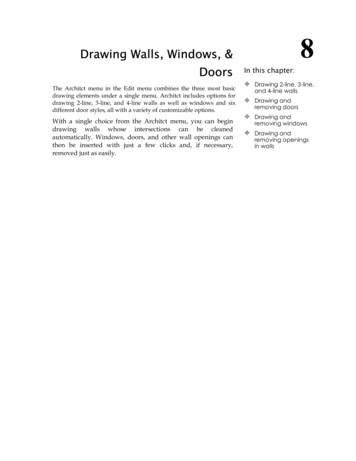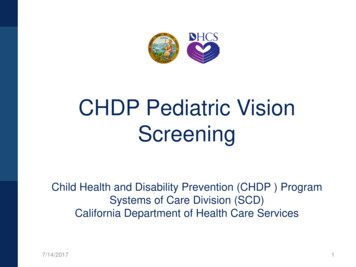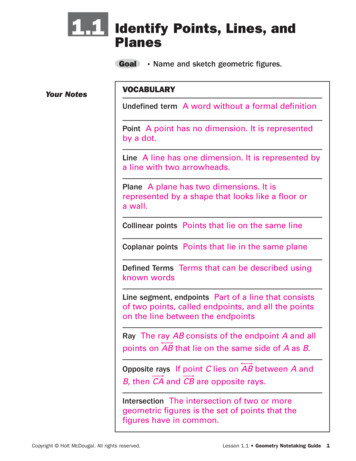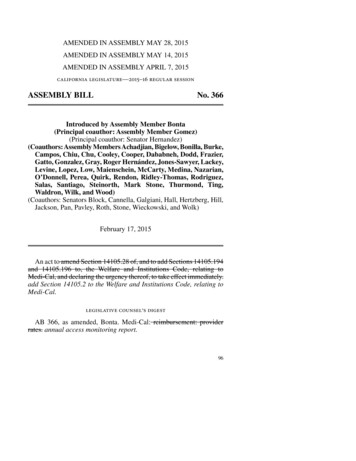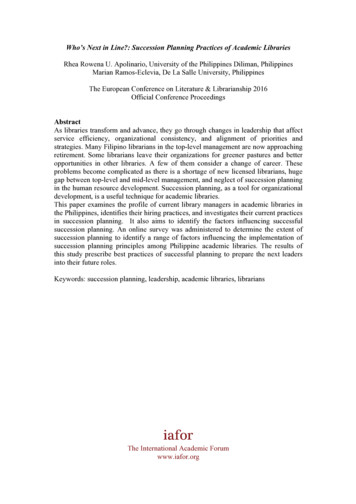
Transcription
Who’s Next in Line?: Succession Planning Practices of Academic LibrariesRhea Rowena U. Apolinario, University of the Philippines Diliman, PhilippinesMarian Ramos-Eclevia, De La Salle University, PhilippinesThe European Conference on Literature & Librarianship 2016Official Conference ProceedingsAbstractAs libraries transform and advance, they go through changes in leadership that affectservice efficiency, organizational consistency, and alignment of priorities andstrategies. Many Filipino librarians in the top-level management are now approachingretirement. Some librarians leave their organizations for greener pastures and betteropportunities in other libraries. A few of them consider a change of career. Theseproblems become complicated as there is a shortage of new licensed librarians, hugegap between top-level and mid-level management, and neglect of succession planningin the human resource development. Succession planning, as a tool for organizationaldevelopment, is a useful technique for academic libraries.This paper examines the profile of current library managers in academic libraries inthe Philippines, identifies their hiring practices, and investigates their current practicesin succession planning. It also aims to identify the factors influencing successfulsuccession planning. An online survey was administered to determine the extent ofsuccession planning to identify a range of factors influencing the implementation ofsuccession planning principles among Philippine academic libraries. The results ofthis study prescribe best practices of successful planning to prepare the next leadersinto their future roles.Keywords: succession planning, leadership, academic libraries, librariansiaforThe International Academic Forumwww.iafor.org
IntroductionAs libraries transform and advance, they go through changes in leadership that affectservice efficiency, organizational consistency, and alignment of priorities andstrategies. Furthermore, challenges to the library profession and the library workforce,such as ageing library staff, generational differences, lack of middle managers, lack ofqualified candidates, and shortages of skills and experience, among others, put a strainon organizational coherence (Singer & Griffith, 2010; Whitmell, 2002).Leaders are necessary in organizations to influence people towards a desireddirection. When leaders leave, organizations must ensure that there is still constancyand stability in their company. Employers must be ready and set to replace theleaders who left. Singer and Griffith (2012, p. 1) said that “to have the right people inthe right place and at the right time only happens when the library has engaged in acontinuous process of identifying, assessing, and developing talent to ensureleadership and management continuity throughout the organization.” This is whatsuccession planning is all about. It is about cultivating individual's capacities inorganizations, therefore empowering them to take on bigger roles and responsibilitiesin their work (Singer and Griffith, 2012).In the Philippines, librarians are also confronted with similar challenges. This isfurther compounded by the shortage of Filipino librarians who will fill the vacantpositions in libraries and information centers (Nera, Ramos and Ananoria, 2012).Library vacancies, especially in the top management positions, cannot be dealt withvacancy after vacancy (Whitmell, 2002). There must be a formal and a clearsuccession plan that ensures continuity in key positions.Succession planning, as a tool for organizational development, is a useful techniquefor academic libraries. In view of this, this paper examines the profile of currentlibrary managers in academic libraries in the Philippines, identifies their hiringpractices, and investigates their current practices in succession planning. It also aimsto identify a range of factors influencing the implementation of succession planningprinciples among Philippine academic libraries.Literature ReviewSeveral works have been written and studies have been conducted on successionplanning in libraries internationally, but there is paucity locally (Bridgland, 1999;Deards & Springs, 2014; Golden, 2007; González, 2013; Hatcher, 1997; Nixon, 2008;Rutledge, LeMire, Hawks, & Mowdood, 2016; Schreiber & Shannon, 2001; Singer &Griffith, 2010; Singer, Goodrich, & Goldberg, 2004; Webster & Young 2009;Whitmell, 2002). These literature discuss the relevance of succession planning inlibraries and the ways to develop people to take on leadership roles.Succession planning, according to Singer and Griffith (2010), is a “systematic effortby the library to ensure continuity in key positions, retain and develop intellectual andknowledge capital for the future, and encourage individual advancement” (p. 1). It istherefore designed to be incessant and owned by management. Singer et al. (2004)believe that for succession planning to work, there must be key imperatives to befulfilled, namely: commitment of top management; ownership; a vision for the
organization’s future; status of present conditions; openness to nontraditional sourcesof talents; and, a well documented training and development program (pp. 39-40).In the Philippines, it is observed that there is difficulty for libraries to look for areplacement when one retires or resigns due to reasons, such as, no one from withinthe organization is qualified to take on the job or no external candidate is applying forthe position. The vacancy would sometimes remain to be unoccupied for severalmonths, or years. Moreover, the relevance of succession planning is overlooked bymanagement, resulting therefore to undocumented or non-existent succession plans.For libraries to move forward, they must be prepared for what the future holds.According to Whitmell (2001), effective succession planning strategies shouldinclude, among others, the following: a formalized managerial and supervisorytraining; job rotation and regular movement between departments and positions;support for training and education; a strategy for individual career movement; formaland informal feedback; formal evaluation periods; mentoring program; managementsupport for employees’ career goals; and, open communication among all employeesin all levels.MethodologyTarget respondents of this study were directors, university librarians, chief librariansand head librarians from 179 academic libraries in the Philippines. The data werecollected in June 2016 through an online survey questionnaire consisting of threeparts, namely: (1) characteristics of library managers, (2) hiring practices of academiclibraries, and (3) current practices of library succession planning. The surveyquestions were adopted from the studies of Rosenwald and Wendell (2013) andGalbraith, Smith and Walker (2012). Personalized emails with the URL of the onlinesurvey were sent to 85 library managers. Call for participation to answer the onlinesurvey was also posted on Facebook pages of some library associations and e-groups.A total of 99 responses were collected yielding a response rate of 55.3%. Afterexcluding invalid responses, 89 responses were analyzed using SPSS.Profile of Library ManagersRespondents of the current study were asked to indicate the type of organizationalstructure of their library. Seventy (70) respondents described their library as a flatorganization with an average of five librarians per library. Academic libraries that areconsidered hierarchical organizations employ an average of 23 librarians per library.As noted by Whitmell (2005), the size of an organization can significantly influenceits “ability to implement long-term workforce plans” due to time constraints and“minimal in-house capacity” to mentor potential successors (p.135). The librarydirector or university librarian is the highest position among the hierarchical libraryorganizations. The majority of the respondents (58.4%) are master’s degree holderswhile a few hold doctorate or PhD units.Figure 1 shows the age distribution of library managers in academic libraries. Themean age of top library managers in this study is 47 years; 40 years for mid-level; and35 years for low-level managers. Consistent with the study of Galbraith et al. (2012),department/section/unit heads are younger than top- and middle-level managers. The
library directors and university librarians tend to be older as they are required topossess more experience in leadership and management. Of the top-level managers,the youngest director or university librarian is 24 years old while the oldest is 68 yearsold, which is beyond the retirement age. Twenty percent (20%) of the totalrespondents are 50 years or older and will retire in the next five to ten years.Figure 1: Age Distribution of Library ManagersHiring Practices of Academic LibrariesAs described by Galbraith et al. (2012, p. 222), succession planning involves“selection and training of internal employees for key leadership positions”; thus, itimplies that when an organization has a succession plan, such gives a preference tohiring internal candidates. Respondents were also asked whether their libraries havepreference to hire internal or external candidates for library management positions.Furthermore, they were asked if they have employed internal and/or externalcandidates. Figures in Table 1 show that while many respondents prefer to hireinternal employees for management positions, they indicated no preference to internaland external candidates in the actual hiring process. Of the 89 respondents, 67 (75%)of them have no written policy that offers a preference to internal candidates.Moreover, 85% of the total respondents do not have a written policy that offers apreference to external candidates. On the average, only 23% of the managerialpositions were filled by internal candidates over the past five years. Surprisingly, only10 academic libraries have consistently hired internal candidates to fill vacantpositions. Almost all of these libraries are private organizations and have a flatstructure.
Table 1. Preferred and Actual Hiring Practices of Academic LibrariesTables 2 presents the reasons for hiring internal candidates for the top-levelmanagement positions. For academic libraries that hire internal candidates or bothinternally and externally, respondents perceived that the transition would be easier asinternal candidates already understand the culture, strategic goals, and values of theorganization. A quick, orderly and clean transition could therefore minimizedisruptions in the workflow when managers leave the institutions (Galbraith et al.,2012; Hopper, 2011; Trickel, 2015). Likewise, respondents believed that hiringinternally improves the morale of library staff and encourages retention of exceptionalpeople. Weare (2015) argued that when an employer gives preferences to internaltalents, it recognizes and appreciates the value of the employees. Furthermore,respondents would also hire internal candidates as they have loyalty and commitmentto the library and university.Table 2. Reasons for hiring internal candidates for the top-level positionsOn the other hand, 11 respondents revealed that they would hire external candidates“who can offer a fresh perspective or new ideas from other libraries (new blood).”Some respondents claimed that external candidates would be more qualified. Otherssaid that internal candidates who might be qualified for vacant positions often do notapply. More so, library managers would hire external candidate to bridge a leadershipmaturity gap particularly when the best internal candidate is not yet ready to assumethe position and the responsibilities (“Top 10 Reasons to Consider ExternalCandidates,” 2016).
Perceived Importance and Succession PlanAlmost 80% of the total respondents have no written succession plan. The majority ofthe respondents (52%) believed that succession planning is extremely important orvery important (see Table 3). When respondents were asked to describe theirsuccession plan, 39 (43.8%) respondents stated that their succession plan is not verywell established. They do not apply succession planning principles, but they providegeneral training for all librarians. Some respondents (19, 21.3%) have a wellestablished succession plan wherein librarians were given specific opportunities todevelop their leadership and management skills. Few respondents occasionallypractice succession planning principles, but not very consistent. Probably, theserespondents do not have a written succession plan to guide them in managingsuccession. Results also indicate that a gap between the perceived importance andpractice of succession planning exists.Table 3. Importance of Succession PlanningPlanning the Succession of Key PositionsWhile the primary responsibility for succession planning lies on the hands of top-levelmanagers, the majority of the respondents said that all librarians participate in thesuccession planning. However, 35 (39.3%) respondents mentioned that “planning isonly done after the current director/university librarian/chief librarian/head librarianhas announced he/she is leaving or retiring soon.” Moreover, 33 (37.1%) respondentssaid that planning is done before the retirement/resignation of library managers, and isan ongoing activity. Only three respondents do not plan at all.When respondents were asked if they could identify someone as director/universitylibrarian/chief librarian/head librarian immediately, the vast majority (72, 80.9%) ofthe respondents said that they could. On the other hand, it would just take them one totwo months to identify a permanent successor. Ten (10) out of 89 respondentsanswered that they could identify their permanent successor in just one day.Interestingly, nine of these respondents do not have a written succession plan.Succession Planning ActivitiesThis study also attempted to evaluate the succession planning efforts of the academiclibraries being studied. Authors of this study modified and adopted the successionplanning scoreboard of Rosenwald and Wendell (2013). A five-point Likert scale wasused to rate each of the 10 statements associated with succession planning process
(see Table 4). Of the total respondents, 43.8% garnered scores 35-45, which indicatethat these academic libraries should assess the activities with lower scores todetermine where to focus succession planning efforts. Scores show that 25.8% of the89 academic libraries could be at serious risk. These libraries should start developingtheir succession plans and identify key activities to improve their situations. Onlyseven respondents yielded scores of 46-50 which means that their libraries are inexcellent condition to manage succession.Table 4. Succession Planning ScoresTable 5. Succession Planning ActivitiesAs shown in Table 5, more than 50% of the respondents said that their librariesevaluate and manage staff performance. The bulk of the respondents mentioned that
their libraries frequently perform the following activities: conduct an inventory oflibrarians' skills, experience and career interests; provide opportunities for middlelevel management to develop their leadership potential (i.e., mentoring); identifyinterested librarians in leadership and assess their capabilities; create a strategy forrecruiting, orienting and developing new library managers; and encourage librariansto work in teams to foster knowledge transfer. Furthermore, the following activitiesare rarely performed in the libraries: top-level management rarely initiates discussionsabout leadership and succession planning with the middle/low level management; themanagement team explains the process of selecting a successor and rationale tolibrary staff; and, library evaluates their success plans.Opportunities to Potential TalentsRespondents were further asked if their libraries implement succession planningprinciples, such as, providing on-the-job leadership opportunities (e.g. projectleadership assignments, temporary managerial assignments, etc.) and providing jobspecific training (e.g. training specific to job duties, general library conferences, orlibrary webinars, etc.) for potential successors. In general, academic libraries in thisstudy frequently offer on-the-job leadership opportunities to potential successors. Thismeans that there is about 70% chance that librarians could have this opportunity. Onthe other hand, respondents have about 90% chance that they could have job-specifictraining. Ten (10) out of the 89 respondents claimed that 100% of the time, theirlibraries have provided the prospective successor training opportunities to honehis/her leadership and managerial skills. Surprisingly, only 16 respondents said that100% of the time, opportunities for job-specific training were given to potentiallibrarians. Findings show that academic libraries tend to offer opportunities for jobspecific training than on-the-job leadership. Many colleges and universities offerfinancial support for librarians to participate in seminars, conferences and training.However, most of the topics focus on performing various library functions and toolittle on developing leadership competencies design for first-line or mid-level librarymanagers.Literature suggest that libraries should develop leadership and mentoring program forpotential successors that would enable them to learn about administrative positions,enhance leadership skills, and become familiar with various leadership styles(Springs, 2014). Leadership experience may give internal candidates a competitiveedge when they are being considered for top-level management positions. Potentiallibrary managers should have leadership skills in the aspects of accreditation andcompliance, fundraising, legal issues and facilities management (Harris-Keith, 2016,p. 315). In addition, job-specific training program must be created to build librarians’competencies particularly in the areas of staff selection, project management, budgetplanning, crisis management, donor relations, and program evaluation (Bridgland,1999; Nixon, 2008). Training and development program should be well documentedas suggested by Singer et al. (2004).Barriers to ImplementationWhen respondents were asked to identify the top two factors that affectimplementation of succession planning principles, the majority of the respondentsselected “little emphasis on succession planning” (53.9%) and “not a priority due to
other initiatives taking precedence (49.4%). As shown in Table 6, lack of talents andlimited financial resources to develop internal talents were not the top two answers. Itcan be deduced that academic libraries have sufficient internal talents to fill vacanciesin the future. As today’s top-level managers would eventually leave their posts,library management should start taking all the necessary steps to prepare its futureleaders and avoid getting trapped in a succession crisis. While many librariansrecognize the importance of succession planning in human resource planning andmanagement, it has not been a priority for them. Galbraith et al. (2012) alsoconcluded that “few institutions have established succession plans that activelyprepare current staff for future leadership opportunities” (p. 222).Table 6. Factors Affecting the Implementation of Succession Planning PrinciplesConclusion and RecommendationFindings show that generally, Philippine academic library managers belong to a flatorganization. Library directors and university librarians tend to be older as they arerequired to possess more experience in leadership and management. While many ofthe respondents prefer to hire internal employees for management positions, theyindicated no preference to internal and external candidates in the actual hiringprocess. For academic libraries that hire internal candidates or both internally andexternally, respondents perceived that the transition would be easier as internalcandidates understand the culture, strategic goals, and values of the organization. It isalso believed that hiring internally improves employee morale and retention.Almost 80% of the total respondents have no written succession plan, but majority ofthem believed that succession planning is extremely important or very important inlibraries, even if the executive team or top management puts little emphasis onsuccession planning. A good number of respondents also mentioned that planning isonly done in their libraries after the current head has announced he/she is leaving orretiring soon. While it is believed that the primary responsibility for successionplanning lies on the hands of top-level managers, the majority of the respondents saidthat all librarians participate in the succession planning.
Therefore, although library managers of Philippine academic libraries understand theimportance of succession planning in their libraries and that they practice successionplanning even without a written succession plan, it is imperative that clear anddocumented succession plan should be in place as a guide for management to ensurecontinuity and organizational survival.Succession planning cannot be dealt with successfully vacancy by vacancy orindividual by individual (Whitmell, 2002). Thus, programs on the discussion andunderstanding of the relevance of succession planning in library and informationcenters should be on the agenda of upper level management. To successfully managesuccession, library management should start incorporating succession planning intotheir strategic goals and objectives. Moreover, implementation of succession planningshould be encompassing all levels of management to “create a surplus of talent”(Bridfland, 1999; González, 2013, p. 413). Instead of asking “What if we train themand they leave?” library directors, university librarians or chief librarians should ask“What if we don’t train them and they stay?” (González, 2013, p. 413). Thus, achange of perspective may change the future direction of academic libraries in thePhilippines. Finally, training/workshops on creating a good succession plan for librarymanagers and librarians are also recommended.
ReferencesBridgland, A. (1999). To fill, or how to fill - that is the question succession planningand leadership development in academic libraries. Australian Academic & ResearchLibraries, 30(1), 20–29. doi:10.1080/00048623.1999.10755074Deards, K. D., & Springs, G. R. (2014). Succession planning and implementation inlibraries: Practices and resources. Succession Planning and Implementation inLibraries: Practices and Resources, i, 1–302. doi:10.4018/978-1-4666-5812-7Galbraith, Q., Smith, S. D., & Walker, B. (2012). A case for succession planning:How academic libraries are responding to the need to prepare future leaders. LibraryManagement, 33(4/5), 221–240. doi:10.1108/01435121211242272Golden, J. (2007). Talent management, succession planning, leadership developmentwhat' needed?. Community & Junior College Libraries, 13(4) 3-6. doi:10.1300/J107v13n04 02González, C. (2013). Succession planning at Notre Dame: lessons for librarians. NewLibrary World, 114(9), 408–415. doi:10.1108/NLW-04-2013-0035Harris-Keith, C. S. (2016). What academic library leadership lacks: Leadership skillsdirectors are least likely to develop, and which positions offer developmentopportunity. The Journal of Academic Librarianship, 42(4), 313–318.doi:10.1016/j.acalib.2016.06.005Hatcher, K.A. (1997). Succession paths for academic library directors.Journal of Library Administration, 24(3), 31-46. doi:10.1300/J111v24n03 03Hopper, R. E. (2011). Internal and external recruits to positions of academic libraryleadership: An exploration of issues (Doctoral dissertation). Retrieved from ProQuestDissertations and Theses database. (UMI No. 3491573)Nera, C.M., Ramos, M.M. & Ananoria, A.M. (2012). Beyond the Bookstacks:Challenges, Issues, Strategies, Open to Librarians of Today (The Roadmap ofPhilippine Librarianship){Powerpoint Slides]. Retrieved %20BFL%20Road%20Map%202012.pdfNixon, J. M. (2008). Growing your own leaders: Succession planning in libraries.Journal of Business & Finance Librarianship, 13(3), 249–260.doi:10.1080/08963560802183229Rosenwald, P., & Wendell, L. M. (2013). Succession planning questionnaire. In WhenLeaders Leave: A New Perspective on Leadership Change. MarketShift. Retrievedfrom /01/SuccessionPlanningQuestionnaire.pdfRutledge, L., LeMire, S., Hawks, M., & Mowdood, A. (2016). Competency-basedtalent management: Three perspectives in an academic library. Journal of Library
Administration, 56(3), 235–250. doi:10.1080/01930826.2015.1105051Schreiber, B. & Shannon, J. (2001). Developing library leaders for the21st Century. Journal of Library Administration, 32(3-4), 37-60. doi:10.1300/J111v32n03 04Singer, P.M. & Griffith, G. (2010). Succession planning in the library: Developingleaders and managing change. Chicago, Ill: ALA.Singer, B. P., Goodrich, J., & Goldberg, L. (2004). Your library’s future. LibraryJournal, 5, 38–40.Springs, G. R. (2014). Mentoring for retention, promotion, and advancement: Anexamination of mentoring programs at ARL institutions. In K. D. Deards & G. R.Springs (Eds.), Succession Planning and Implementation in Libraries: Practices andResources, (vol. I, pp. 45–62). Hershey, Pennsylvania: Information ScienceReference. doi:10.4018/978-1-4666-5812-7Top 10 Reasons to Consider External Candidates. (2016). Retrieved August 12, 2016,from rickel, M. M. (2015). The exploration of executive leadership succession planningstrategies in New Jersey community colleges (Doctoral dissertation). Retrieved fromProQuest Dissertations and Theses database. (UMI No. 3731183)Weare, W. H. J. (2015). Succession planning in academic libraries: A reconsideration.In S. S. H. Hines & M. Simons (Eds.), Library staffing for the future (Advances inLibrary Administration and Organization, (vol. 34, pp. 313 – 361). Emerald GroupPublishing Limited. doi:10.1108/S0732-067120150000034013Webster, D. E. & Young, D. J. (2009). Our collective wisdom: Succession planningand the ARL Research Library Leadership Fellows Program. Journal of LibraryAdministration, 49(8), 781-793. doi:10.1080/01930820903396764Whitmell, V. (2002). Library succession planning: the need and challenge. Aplis,15(4), 148–154. Retrieved fromhttp://ezproxy.auckland.ac.nz/login?url http://search.ebscohost.com/login.aspx?direct true&db anh&AN 9227861&site ehost-live&scope siteWhitmell, V. (2005). Workforce and succession planning in special libraries.Feliciter, 51(3), 135–137. Retrieved fromhttp://ezproxy.simmons.edu:2048/login?url https://search.ebscohost.com/login.aspx?direct true&db lls&AN 502946360&site ehost-live&scope siteContact email: rhea@slis.upd.edu.ph, marian.eclevia@dlsu.edu.ph
Importance of Succession Planning Planning the Succession of Key Positions While the primary responsibility for succession planning lies on the hands of top-level managers, the majority of the respondents said that all librarians participate in the succession planning. However, 35 (39.3%) respondents mentioned that "planning is





